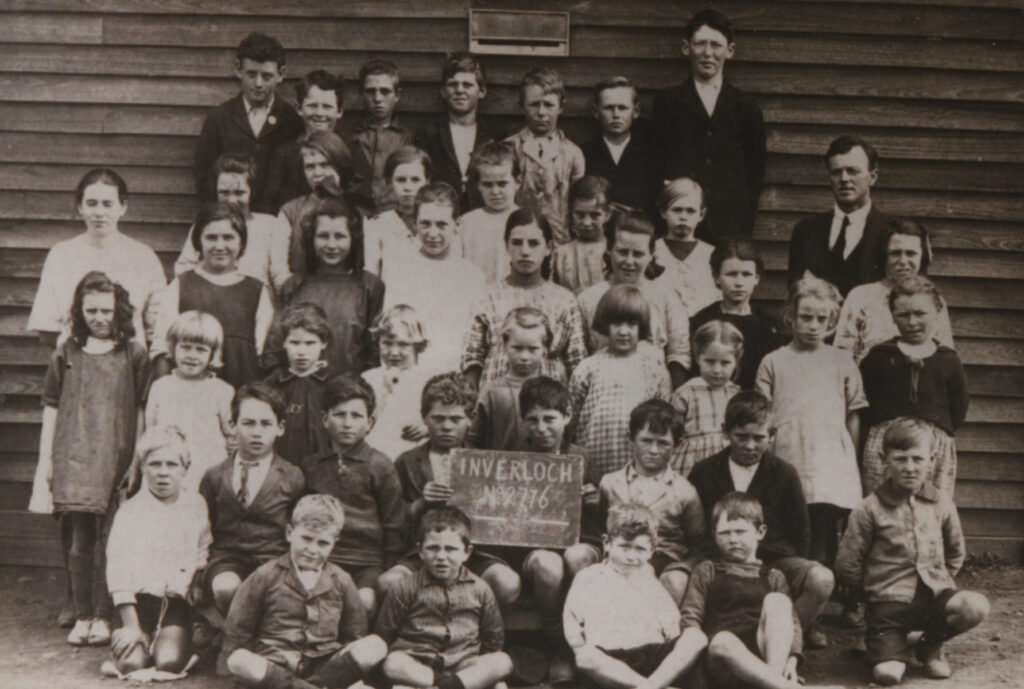Some Foreshore news from the 1936-37 Holiday Season.
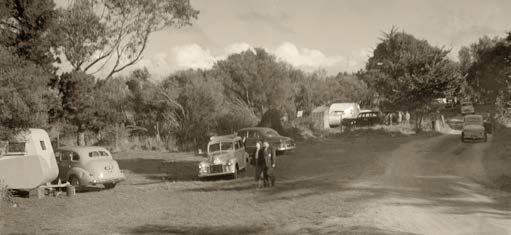
The following article is part of a larger work written by Bill Ramsey JP for the 1936-37 Inverloch Holiday Carnival, which ran from the 26th. December to January 2nd.
“The growth of the Carnival has been in step with the general progress of the town. From a one day carnival it has been extended to a three day function, embracing suitable days during the Christmas – New Year period. The added number of tourists each year began to demand and expect better facilities both for amusements and in the general way of service. By enlarging the Carnival, a larger field of amusement was created, and the major issue, the profits derived from it have been appreciated. The money that has constituted the profits of the Carnival, has always been devoted solely for the purpose of providing those facilities for tourists on the reserve, which are so essential, and which, with the constantly growing demands, require still further improvement. The struggle for the institution of public utilities and the development of the town to the intermediary stage is worthy of review.
Inverloch has been no different to other seaside resorts situated outside the metropolitan radius. Lacking a population enough to finance the various utilities so essential to the common welfare of the people, such as water supply, sanitation, etc ,the whole of the responsibility for augmenting and maintaining such services on the public reserves has fallen upon the shoulders of the local committee. In the successive years prior to 1924, the number of tourists frequenting the beaches had been steadily growing, and the demand for public services became so acute that the Foreshore Committee of the day was compelled to borrow money to implement both the water supply and sanitary conveniences. Since then, the position has been such that constant additions to the service were necessary each year, and the committee has been faced with the problem of finding still further avenues of finance to meet the growing requirements. To add to the various troubles of the Committee, that of foreshore erosion began to become serious in 1930. Prior to that date, the erosion that had been taking place was more or less normal, but by some strange freak of nature, the extremity of Point Smythe began to rapidly wash away, and within the space of two years, at least half a mile of this peninsula which had formed a natural shelter for the beaches on the Inverloch shore, had completely disappeared. From then on, when rough seas occurred, the ocean rollers pounded in on the main beaches, with the result that sand and vegetation began to be rapidly destroy them.”
Our Patron addresses the Catholic Woman’s League
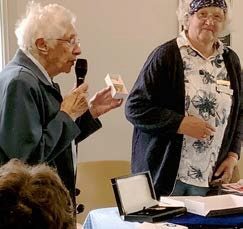
The Society is called upon by various community groups and organizations throughout the year to address them about aspects of Inverloch.During April our Patron – Eulalie Brewster OAM, addressed around thirty ladies belonging to the Catholic Woman’s League who assembled for their Annual Regional Conference at the Inverloch Catholic Church.
Having spoken to a number of the ladies myself,who are also members of our own Society, they tell me Eulalie thoroughly entertained them, brought many smiles to members faces and even some laughter. She talked about Inverloch, but also about her unique experience in receiving her OAM award at Government House in Melbourne under rather dificult COVID19 restrictions.
All Society members know that Eulalie commands not only our wide respect for her local knowledge, but for her amazing ability as a senior citizen to give such authoritative talks without any notes. But being a well trained and organized former Primary school teacher, her quality ‘talks’ come as no surprise to former teachers like myself.
Well done Eulalie!

Recent acquisitions at the Green Shed
Happily we are not overwhelmed by recent acquisitions, which is most fortunate to a degree, simply because there is so much to do with materials, maps, writings and 3D objects still awaiting official entry into our records. With no electric power in the shed as yet, it is not to the warmest place to work in!
Two recent acquisitions are worthy of note – for the first one – a large green, rusted weighing machine, minus its tray, was handed in by our former President, Vern Burchett. The obvious question was – to whom did the machine belong? Investigations by myself and others, seem to confirm it was located in Bank’s Butchers Shop in the old Ramsey building, after showing Adrian Banks a photo of it.
Ian McBurnie brought along several books and folders of considerable interest, donated by Thelma Asbury of Yarra Junction in the Yarra Valley.
One book was huge, boasting 895 pages, and was entitled “Lines, Mines, People and Places’. It was written by Barry Sykes. Centred generally about South Gippsland, and dotted throughout with gems of information and pictures, and supported by the Korumburra Historical Society, it is the second large book written by the author – the first being principally about Outtrim and Jumbunna. More about those two interesting places can be found in the new book. For those of us whose fascination lies in finding out about vanishing towns, there is much to ponder and investigate in Barry Sykes new book.
The two other publications donated to us, were collected and brought together by Donald Nicholson. These folders are difficult and challenging reading. One is about digging for gold in Inverloch. This was the gentleman who persistently dug around the town and along the way making what turned out to be extravagant claims. He was certain he knew where Martyn Wyberg had hidden the famous gold from the steam ship “AVOCA”. His digging lasted from 1938 to1954 when he died.
His other folder, of what is basically photocopied letters from himself and responses from various government agencies, centres around a claim by him that he had invented something to do with ‘Cosmic Electrons’, and that his work could assist the Federal Government in their war effort.
It is all heavy reading, remarkable claims, and official responses which were very measured and careful. Whether or not his invention had any solidity or sense, is hard to fathom.
More Gems of information about Inverloch.
This is the second part of writings from Wilma Hoppen. As the daughter of Bill Ramsey, she writes with great knowledge and detail about Inverloch of the past.
“Dad was President of the Foreshore Committee until 1967, so he was always involved in the Miss Inverloch contest. Miss Inverloch started in 1934 and the prize for the first years until after the war was donated by Bruce Small of “Malvern Star” bicycles, who later went to the Gold Coast. We also started the first male bathing beauty contest and Ted Whitten (Mr. Football himself!) was one of the first winners. The foreshore in those days was a bit like Rosebud. It was occupied totally by working class families who spent their six weeks holiday there, and their husbands drove back to the Latrobe Valley to work, That was the way people had their holidays.
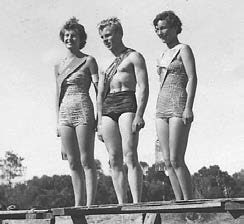
Remembering the shop – in its day it was a very modern shop. There was electricity but no refrigeration, so we had ice chests for the butter, and there was a Cheese Room which was apparently quite a novelty in those days. The cheeses were on marble and kept cold. In the wartime, my job as a child was to paste all the coupon tickets for the butter, tea, sugar etc., and we had to do that every night. There were petrol pumps out the front which were hand pumped – no electric. That was a job I hated. The horse was in the paddock at the back. We also had big sheds with all the wheat and produce for the farmers to buy. We always had to have cats to catch the mice.
Dad was on the Cemetery Trust and the Fire Brigade. There were very few funerals at the Inverloch Cemetery – they all went to Wonthaggi. He was also on the Rocket Brigade, and he was very glad that they never had to fire it, as they had never fired one straight in all their years – this was before 1930. They were quite hopeless and people standing close by, got caught in the rope.
After Dad retired, apart from the Water Trust, he was Chairman of the Joint Coal Committee from 1950 to 1960, which settled disputes in the Wonthaggi mines.
The Inverloch school comprised of two rooms. Mrs. Harmer was the Primary teacher in the Infant room. A teacher from Inverloch who gained fame was Doug Brown, who taught in Inverloch in the early 1940’s. He married one of the Goodmans. He went on to become President of the Victorian Teachers Union, and then the teacher representative on the Victorian Tribunal which set the wages for teachers in the 1950’s and 1960’s.
After Inverloch I went to the Wonthaggi Technical School. The bus picked us up at 7.30am. and the drove around Kongwak and Glen Alvie, and it took that amount of time to get to school. After school you came back the long way because the children on the farms were required at home to help milk the cows, so we didn’t get home until about 5.30pm. Freddy Webb ran the buses in those days. I went to school until Matriculation (Year 12), and then I did a student teacher year in 1949. I went to Teachers College the following year.”
From the President
This is my last contribution to the Newsletter as your President, an office I have held for five years. It has been five years of many ‘ups’ and ‘downs for the Society and myself, but the major achievement has been the arrival of the Green Shed in the grounds of Warrawee. We finally have a central place to store and list our ‘treasures’ – one almost needs to take a deep breath at that achievement for us all!
I take great pleasure in looking back over the years highlights, which include the book “Inverloch – a place of Great Beauty, Today & Yesterday”. We sold every copy and made quite a few dollars for the Society.
Three major exhibitions were organized for The Hub, and proved to be highly successful. For those exhibitions I produced 172 display cards, a task which gave me great individual pleasure.
We also, through the good works of our former secretary Graham Paterson and our current photographic art restorer Ray Burtt, produce well over 40 large canvas prints which sit in our Green Shed which can be used for future exhibitions. Ray has also, using his considerable talents, produced numerous quality photographic prints which we sell commercially through a shop in Inverloch, thus increasing our fund raising to help in future preservation.
Former secretary Lynn Kirk has set up a fine system in our Green Shed, plus a computerized accessioning system that has already proved its worth.
I am not a modern technological ‘guru’ and I have great difficulty with my computer and communication skills. Several Society members, plus my close friend Graham Wilson, have lifted me out of my computer doldrums, to a passable understanding of how to go about problems. It is therefore a measure of my great appreciation of Rod P with the magnificent web site he has created for us, which he regularly updates.
I will not be seeking election to any post, and neither do I wish to be on the Committee. We need new blood, new ideas – and what’s more – modern leaders with technological skills that can widen, broaden and improve the aims and aspirations of the Society.
Thank you sincerely for your support over the years.
JOHN HUTCHINSON
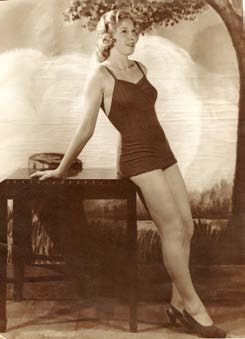
Future Meetings & Meeting Place change
Our next GENERAL MEETING will be held at the RSL Hall on Wednesday June 23rd. starting at 2pm. There will be a guest speaker, followed by the traditional cuppa.
Our 2021 ANNUAL MEETING (AGM) will be held on Wednesday July 28th. at the Anglican Church Hall in The Crescent, commencing at 2pm. It will be followed by a General Meeting.
For many years we have had all our meetings at the RSL Hall in Bolding Place. We sincerely thank the RSL for the use of their hall.
All meetings in the future, commencing with the July AGM , will be held at the Anglican Church Hall. There is plenty of parking space for cars, and we thank the Anglican Church for the use of their fine facilities. The Committee has endorsed the change.
